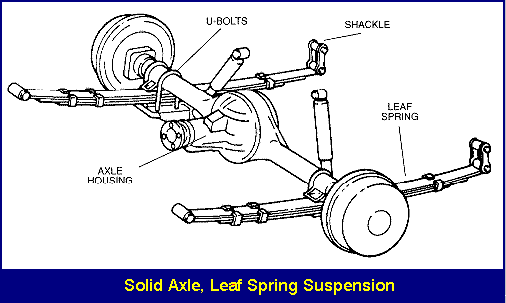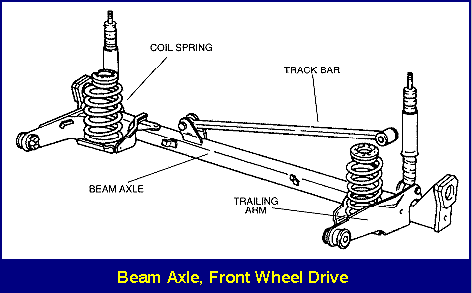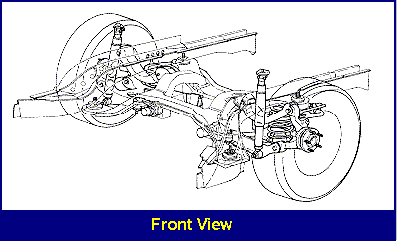REAR SUSPENSION
Just as we discussed with front suspensions, there are two types or rear suspensions: dependent and independent.
Dependent Rear Suspensions
There are two major types of dependent rear suspension: the solid axle used on rear-wheel drive vehicles, and the beam axle used on front-wheel drive vehicles.
Solid Axle, Leaf Spring
The solid axle design uses either leaf spring suspension or coil spring suspension. At one time, the solid axle leaf spring suspension was the most common design.
Its design is very similar to the front solid axle design discussed earlier. However, in this design the I-Beam is replaced with a drive axle housing, which is suspended and attached to leaf springs. The axle housing is held in place on the leaf springs by large U-bolts.
Rubber bushings are used at the front and rear of the leaf spring to reduce road shock and vibrations. The spring itself is attached to the vehicle frame through shackles at the rear, and bolts at the front.
The front part of the leaf spring acts as a control arm, holding the axle in line to control wheelbase and maintain proper tracking. The front part of the spring is shorter than the rear part. This reduces axle wind rotation (sometimes referred to as wind-up) and increases control.

Solid Axle, Coil Spring
As it turned out, the leaf spring suspension was great for load carrying vehicles, but it wasn’t very well suited to passenger cars. Because of its extensive unsprung weight and stiff springs, it produced a somewhat harsh ride.
The rear coil spring suspension is a variation of the rear leaf spring suspension often found in rear-wheel drive vehicles; the leaf springs have simply been replaced with coil springs.
Because coil springs are lighter, they have less unsprung weight, creating a smoother ride. However, coil springs can’t be used to hold the axle in line and so we have to rely on other methods.
The typical rear coil spring suspension uses two lower control arms to control wheelbase, and one or more upper control arms to control side motion and axle rotation.
If only one upper control arm is used, a track bar is also needed. This bar connects to the axle at one end and runs across the vehicle to connect to the frame at the other end. Rubber bushings are used at each end to reduce vibration and allow for compliance as the suspension travels through jounce and rebound.
If two upper control arms are used, there is no need for a track bar. However, these upper control arms must be mounted at an angle. The control arms are connected to the axle and the vehicle frame through rubber bushings, similar to the ones used on the front suspension.

Beam Axle, Front-Wheel Drive
The beam axle is an example of a dependent rear suspension, which is used on front-wheel drive vehicles. It is lighter than rear suspensions on rear-wheel drive vehicles because it is not a drive axle.
The stamped beam axle uses coil springs and trailing arms, with a track bar to control side-to-side movement. However, just as with the front wheels in a solid axle suspension, the rear wheels are mounted on the same axle. As we said earlier, this means that the up and down movement of one wheel can affect the other wheel. Although these movements are slight, they can cause problems in handling and vehicle control.

Twist Axle, Front-Wheel Drive
A modified version of the beam axle is a somewhat independent rear suspension called a twist axle. In it the wheels are supported by individual trailing arms that are connected to one another by a V-, U-, or I-shaped axle beam.
A flexing action takes place, due to the location of the axle beam in relation to the centre line of the rear wheels and the pivot points of the trailing arms. For example, when one wheel contacts a bump in the road, the axle twists, allowing the wheels to respond somewhat independently. Another advantage of this design is that the axle shape resists bending.

Independent Rear Suspensions
There are two types of independent rear suspensions typically found in passenger cars and light trucks.
Trailing Arm
The trailing arm suspension is also known as the control arm suspension. It is becoming more common in rear-wheel drive applications in both passenger cars and light trucks. The advantage of this design is that it allows both rear wheels to move independently.

Short-Arm/Long-Arm
A newer design of rear suspension is the short-arm/long-arm suspension. This suspension is mounted on a sub frame. The two lower control arms control the wheelbase, while the two upper control arms control lateral or side-to-side movement. The steering knuckle, which houses the half-shaft, is made of cast aluminium. Variable rate coil springs are standard equipment on this suspension design.

